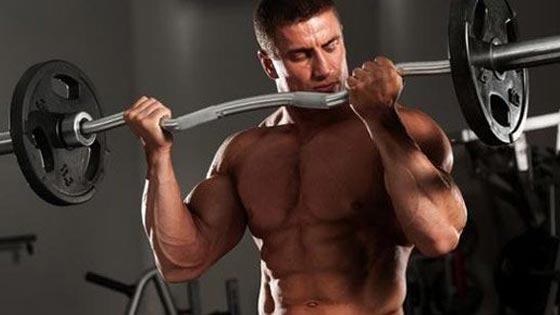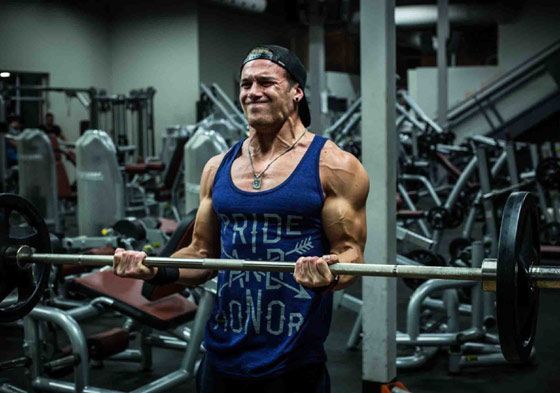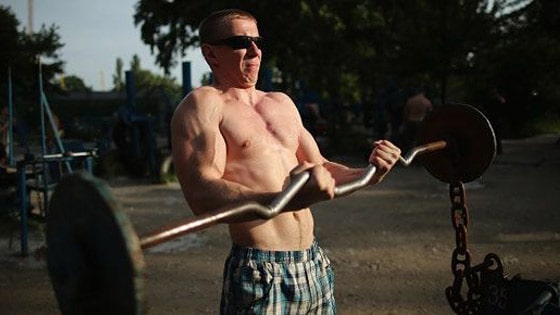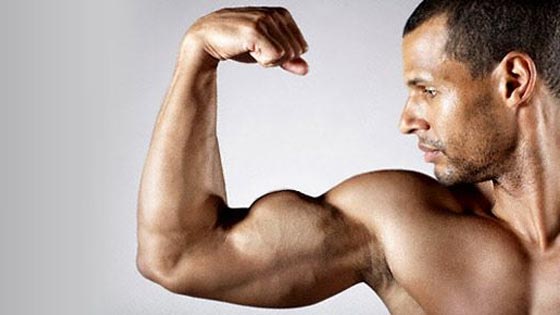How to do barre curls?

The standing barbell curl, or “barbell curl ”, is a basic bodybuilding exercise to strengthen your arms, particularly the biceps. The barbell biceps curl is one of the most popular arm exercises in weight rooms and is often included in workout programs and routines. This is a good choice if you are looking for bigger and stronger arms.
Obtaining good biceps is often the goal of most bodybuilding practitioners, especially men, because this muscle is a symbol of strength and masculinity. Conversely, women want thin, toned and tapered arms.
Whether your goal is to strengthen your arms or get massive biceps, the barre curl can help you. This essential exercise for biceps strength training effectively targets and isolates this muscle. But to achieve results and gain strength in the arms, you will need to use good execution technique and do the exercise correctly.
How to do the barre curl correctly? What precautions should be taken? What are the main variations of this exercise? And what is the most effective exercise for the arms? All the answers to your questions below.
Why do barre curls?
Yes, why do this exercise for the biceps? And why use a curl bar? Here are the main benefits of bicep curls.
 The barre curl is one of the best exercises for developing arms. It is a simple, accessible and effective exercise for gaining biceps mass if you do it regularly. In addition to the aesthetic side, stronger biceps will help you perform better on other exercises like pull-ups or rows . Because it is common to be limited in these exercises by a lack of strength or endurance in the arms. Also, the curl bar strengthens your grip strength and your forearms. You will actually feel them working during the exercise. It also allows you to lift heavier weights compared to other biceps exercises, and therefore add more muscle.
The barre curl is one of the best exercises for developing arms. It is a simple, accessible and effective exercise for gaining biceps mass if you do it regularly. In addition to the aesthetic side, stronger biceps will help you perform better on other exercises like pull-ups or rows . Because it is common to be limited in these exercises by a lack of strength or endurance in the arms. Also, the curl bar strengthens your grip strength and your forearms. You will actually feel them working during the exercise. It also allows you to lift heavier weights compared to other biceps exercises, and therefore add more muscle.
How to build biceps muscle quickly? Make the barbell curl the basis of your bicep strength training program. And include it in your workout routine.
What muscles does the barre curl work?
What muscle does the barbell curl work? In short, the biceps brachii , short and long portion, the brachialis anterior and the long supinator.

As with most exercises, several muscles are involved in the movement, and this is also the case with the barbell curl. The biceps brachii does most of the work, the short portion – on the inside of the arm – and the long portion – on the outer side of the arm – are heavily used. The brachialis, hidden under the biceps, also participates in the elbow flexion movement. And for the forearm, the long supinator or brachioradialis is used. In fact, all of the wrist and finger flexors are involved in stabilizing the movement, which is why you may feel a lot of congestion in the forearms during the barbell curl.
How to do barre curls correctly?
- In the starting position, you stand with the bar in your hands, supinated, approximately shoulder-width apart. This rests in front of the thighs, and your back is still and straight. The knees are slightly bent – or one of the legs can be moved forward to avoid cheating – and the elbows are close to the body.
- Inhale then raise the bar with the strength of your arms, bending your elbows, but without moving them forward – keep them against the body – without breaking your wrists and keeping your torso vertical.
- When you reach the top, exhale and lower the bar slowly to the initial position, without completely straightening your arms. Keep a slight “flex”!
- Do all the repetitions of your series then place the bar neatly on the floor or on the rack without rounding your back.
Breathing
Inhale at the start of the movement when the arms are straight, and exhale when bending. If the weight is heavy, inhale and raise the bar while holding your breath, then exhale once the difficulty part is over.
Tips for doing the barre curl correctly
Now that you know how to do the barre curl, here are some training tips and mistakes to avoid when performing the exercise. Enough to maintain good technique and get the most out of the movement.
 Cheat with your back and bring your elbows forward. On this exercise, we often see that practitioners cheat and use momentum by leaning forward and giving an impulse with their lower back. Then, they move their elbows forward with the help of their shoulders. The reason? The load is almost always too heavy. By performing the exercise in this way, the biceps are not used over the entire amplitude and fiber recruitment is not maximum. Muscle stimulation and therefore development will be damaged.
Cheat with your back and bring your elbows forward. On this exercise, we often see that practitioners cheat and use momentum by leaning forward and giving an impulse with their lower back. Then, they move their elbows forward with the help of their shoulders. The reason? The load is almost always too heavy. By performing the exercise in this way, the biceps are not used over the entire amplitude and fiber recruitment is not maximum. Muscle stimulation and therefore development will be damaged.
For good form, keep your arms pressed against your sides and perpendicular to the ground. To avoid momentum, keep your back still and straight, knees bent, or bring one leg forward to stabilize the body. It is also possible to perform the exercise even more strictly by keeping your back against a wall. This avoids cheating, and this is also how it is performed during barbell curl competitions.
 Control the descent. When you lower the bar back down, make sure you do it slowly and don't drop the bar quickly. As you know, the negative part is very important when it comes to muscle gains, and not controlling the bar can increase the risk of injury. For this you may need to decrease the weight slightly. But regardless, the goal is to stimulate your muscles not to lift weights.
Control the descent. When you lower the bar back down, make sure you do it slowly and don't drop the bar quickly. As you know, the negative part is very important when it comes to muscle gains, and not controlling the bar can increase the risk of injury. For this you may need to decrease the weight slightly. But regardless, the goal is to stimulate your muscles not to lift weights.
 Load to use. Use a load that allows you to have good, strict technique.
Load to use. Use a load that allows you to have good, strict technique.
 Plug to use. The most classic grip on the bar is supinated hands (palms facing the face) with a distance of approximately shoulder width. It is possible to touch one of the two bundles of the biceps more or less intensely. If you want to work on the long portion of the biceps (outside the arm), you must take a tight grip. Conversely, to aim for the short portion, you must take a wide grip. Grip of the bar in pronation (reverse grip) or hammer grip (semi-pronation), places part of the effort on the long supinator, a muscle which crosses the entire forearm and which joins the humerus. The muscles of the forearm, the wrist extensors, are also put to the test. In both cases, the anterior brachialis (under the biceps) will be used by these exercises. The biceps brachii also, but less.
Plug to use. The most classic grip on the bar is supinated hands (palms facing the face) with a distance of approximately shoulder width. It is possible to touch one of the two bundles of the biceps more or less intensely. If you want to work on the long portion of the biceps (outside the arm), you must take a tight grip. Conversely, to aim for the short portion, you must take a wide grip. Grip of the bar in pronation (reverse grip) or hammer grip (semi-pronation), places part of the effort on the long supinator, a muscle which crosses the entire forearm and which joins the humerus. The muscles of the forearm, the wrist extensors, are also put to the test. In both cases, the anterior brachialis (under the biceps) will be used by these exercises. The biceps brachii also, but less.
 Cuffs. You can use an EZ (angled) bar to avoid strain on the wrists if the straight bar is a problem. This is particularly the case if you have elbow valgus.
Cuffs. You can use an EZ (angled) bar to avoid strain on the wrists if the straight bar is a problem. This is particularly the case if you have elbow valgus.

Marc Fitt on the barre curl – A biceps isolation exercise not so easy to master…
What are the variations of the barre curl?
There are many variations of the barre curl and also alternative exercises. On this exercise, you can vary the grip (pronation, supination or neutral), the width between the hands, and use benches, machines and various accessories. The bar curl can be done on the low pulley using a straight bar, an EZ bent bar or even with a rope. Here are the most popular variations.
PRONATE BAR CURL
It's the same exercise on the bar except that the grip is reversed, in pronation. The reverse curl is a good bodybuilding exercise to work the brachialis anterior, the muscle located under the biceps and which gives volume to the lower part of the arm, as well as the muscles of the forearm (like the long supinator) and wrists.
CURL EZ BAR
This variation of the bar curl is done with an EZ or angled bar. Compared to the straight bar curl, the EZ bar is significantly more comfortable in the wrist joint. And the EZ bar works the same muscles with just as much intensity.

CURL AT THE DESK
The desk curl or Larry Scott curl is a variation where the elbow is advanced in relation to the chest. It can be performed with a barbell, a dumbbell or on a machine . This exercise minimizes cheating and allows you to concentrate on the movement, although it is always possible to gain momentum with your torso by lifting your buttocks from the seat... By tilting the desk, this curl tends to recruit the brachialis anterior than the biceps .
The desk curl has the reputation of giving a “peak” to the biceps, but some criticize it for being useless or even dangerous. For what? Because on a 45° desk with a bar, the biceps relax at the top of the movement. And at the bottom of the movement, the risk of tearing your biceps or long supinator is very real. This is why you should never completely straighten your arms when lowering the bar. A better alternative is to use a machine to keep tension in the muscle, doing a vertical desk curl or spider curl .
SEATED BAR CURL
This variation where you sit on a bench prevents you from cheating and taking advantage of the momentum. You are more stable, which allows maximum concentration on the biceps. And the shorter range of motion lets you lift good weights.
LOW PULLEY CURL WITH BAR
The low pulley curl is a very effective strength training exercise for the biceps. Unlike the classic barbell curl, with the cable you obtain constant tension on your biceps muscles throughout the movement. In addition, this exercise is very safe and minimizes the risk of injury. And the machine is very practical for easily adjusting the weight, allowing you to do decreasing series.
Bar Curl FAQ
WHAT DIFFERENCE BETWEEN WIDE AND TIGHT GRIP?
The width of the bar grip when curling has an impact on the work of the biceps. The standard grip is shoulder width, and is the one we recommend. The position with the hands wider apart will encourage the work of the short portion of the biceps (on the inside of the arm) while the tight grip will work more on the long portion of the biceps (on the outside of the arm).
WHAT WEIGHT TO USE FOR THE BAR CURL?
Beginners can start with the empty bar and progress from there. The important thing is to apply progressive overload and use good technique. (See: How to progress in bodybuilding )
For advanced weight lifters, if your goal is hypertrophy, use moderate weights and a medium rep range. Aim for 3 to 4 sets of 8 to 12 reps with 1 min 30 sec rest between sets. If your goal is to gain strength, opt for heavy weights and few repetitions. 3 to 5 sets of 4 to 8 repetitions. With rest times of 2 to 3 minutes. The barre curl, as an isolation exercise, is not necessarily suitable for very short sets of less than 5 repetitions.
WHAT BICEPS PROGRAM TO DO?
To progress in biceps curls, you can include a curl session in your full-body program after the basic exercises:
- Curl bar: 3 x 12
In split, do these 3 exercises on arm day:
- Curl bar: 4 x 10
- Dumbbell curl: 4 x 8
- Concentrated curl: 3 x 12
Opt for this advanced arm program that works them twice a week if you want to literally explode your arms.
I TEND TO CHEAT WITH THE BACK AND SHOULDERS AT THE CURL BARRE, WHAT TO DO?
You're probably putting too much weight on it. Review your execution technique to do a strict barbell curl. The goal is above all to grow your muscles, not to lift a load for the ego. You can also do a curl with your back resting on a fixed support or a wall. This will prevent you from cheating. In this case, seriously reduce your workload and start again on this good basis.
HOW TO BUILD YOUR ARMS QUICKLY?
Gaining muscle takes time. Wanting to build muscle quickly and skipping steps can be counterproductive and even slow down your progress. Try to progress from session to session and be regular. Don't forget to get plenty of rest outside of the gym and eat well. Also note that biceps training remains secondary to basic movements such as presses, dips, pull-ups or rows which will allow you to gain a lot of muscle mass in your chest and arms. You should give them priority in your strength training program and possibly add some arm exercises like the barre curl to supplement.
HOW TO Build BICEPS AT HOME?
It's difficult to build your arm muscles at home if you don't have the equipment. If you have something to hold on to, bodyweight pull-ups with supinated hands are effective for strengthening the biceps. To curl, you will need to invest in a straight bar and some weights, or use dumbbells or elastics.
I HAVE GAINED ARM SIZE, BUT THEY STILL LOOK THIN. FOR WHAT?
Several factors can affect the appearance of your arms. Size for example. A tall person with long limbs will always appear to have fewer arms than a short person with the same arm size. For it to “look” good, the big guy will have to gain a lot of volume in the arms, biceps and especially triceps.

Also, your arm size is influenced by your bones and your build. A person with a wrist circumference of 16 cm and an arm of 39 cm will have a good level. The one with a 20 cm wrist circumference will be able to reach a 45 cm arm circumference, also a good ratio. So if you start with 30 cm of arm circumference and thin wrists, aim for a realistic ratio of 40 cm maximum after several years of bodybuilding. And don't focus on the champions, with Arnold and his 55 cm arm circumference.
The insertion of the muscles also affects the appearance of the biceps. Some have short biceps and others long. Contract your biceps and measure the length of your tendon. If you can fit more than 2 fingers on it, your biceps are considered short. Conversely, they will be classified as long. The long biceps are ideal for obtaining big, full arms, while the short biceps will have less volume... But the short will give you very prominent biceps once contracted, in the shape of a ball. In short, it's a question of genetics, there's not much you can do about it and you'll have to live with it.
.png)